Winter is coming… to Europe. As the temperatures drop and the leaves start to fall I find myself longing for those long summer days.
I’m a summer person through and through, winter makes me sad and I’m always searching for a warm escape during the long winter months.
Ideally I’d like to jet off to the Caribbean and spend my winters there, but that’s not very practical unfortunately.
Just like me, I know there are lots of other people who are searching for winter sun in Europe, so that they can escape the cold without having to fly half way around the world.
If you’re reading this article, chances are you’re one of them! I teamed up with other travel bloggers to bring to you the ultimate guide to winter sun destinations in Europe.
We have listed all the warmest places in Europe in winter, which you can visit anytime from October to March.
These are the places you can run off to for a weekend getaway or longer, and expect to find pleasant temperatures, mostly clear days and the opportunity to enjoy some winter sun!
Contents

Enjoying the sunshine in Corralejo, Fuerteventura, at the end of October
Warmest places in Spain in winter
Barcelona
I couldn’t kick off this European winter sun compilation with anywhere other than some of my favourite spots in Spain.
Spain is blessed with some of the mildest temperatures in Europe, so it’s only natural that most of the warmest destinations in Europe in winter would be in Spain.

The Sagrada Familia in Barcelona, Spain
One of my personal favourites is Barcelona. Barcelona is the capital of the Catalonia region and one of the main cities in Spain.
In the coldest months of the year the temperatures are still around 15°C, and the city sees on average 5 days of rain a month. While it’s far from the heat of the tropics it’s the perfect weather to enjoy a winter city break.

Enjoying the view from the Bunkers del Carmel, Barcelona
Barcelona is on the beach but if you’re visiting during the peak winter months it’s unlikely you will be heading to the beach.
Instead, you can spend your days in Barcelona wandering around the Gothic neighbourhood, shopping on the famous Rambla, discovering the Gaudì architecture dotted around the city and enjoying tapas and Spanish food of all sorts.
Despite being a big city it still has a very chill vibe, where you can enjoy not only a few days in the sun but also a more relaxed pace of life.
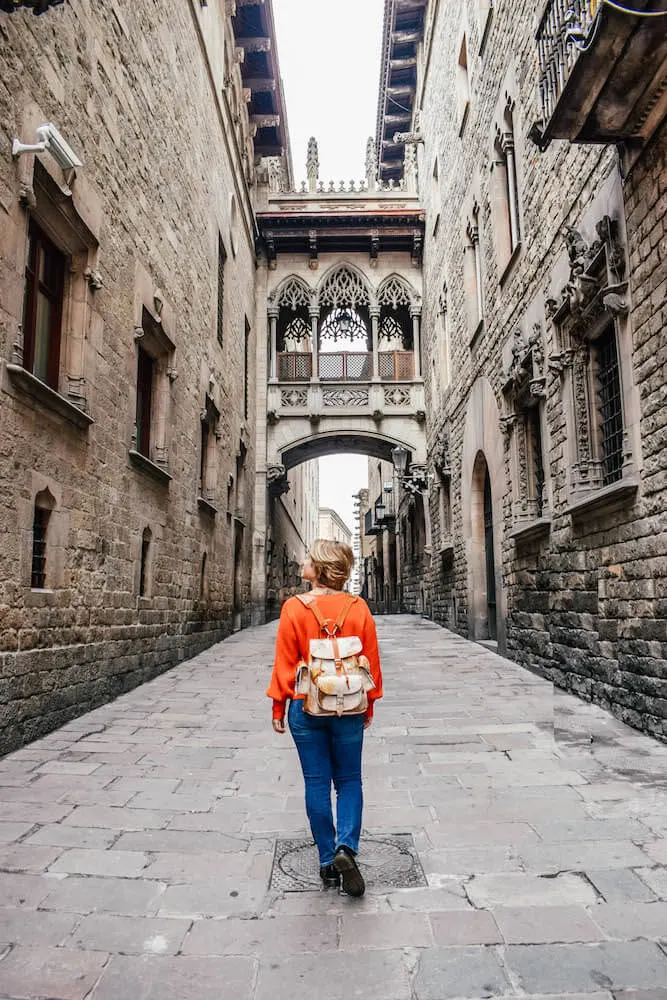
The famous arched street of the Gothic Quarter of Barcelona, Spain
Seville
Seville is another Spanish city that I love and think is a perfect warm winter getaway in Europe. I went to Seville for a weekend in February and was surprised at how warm and pleasant it was.
Coming from London, the 16°C to 18°C of Seville in winter were exactly what I needed. There are lots of fun things to do in Seville, most of them being cultural and historical sightseeing activities.
The main attractions in Seville are the Real Alcazar, the largest royal palace still in use, Seville cathedral, the largest Gothic cathedral in the world, and Plaza de Espana, a spot that Star Wars fans might recognise!
There are also loads of lovely restaurants all around the city, where you can enjoy some delicious paella, tapas or bocaditos.
When I travel I usually search for beach or hiking getaways, but if you don’t have very long and just want a warm and chill city break, Seville will give you just that.

Watching the sunset over Seville from the Metropol Parasol
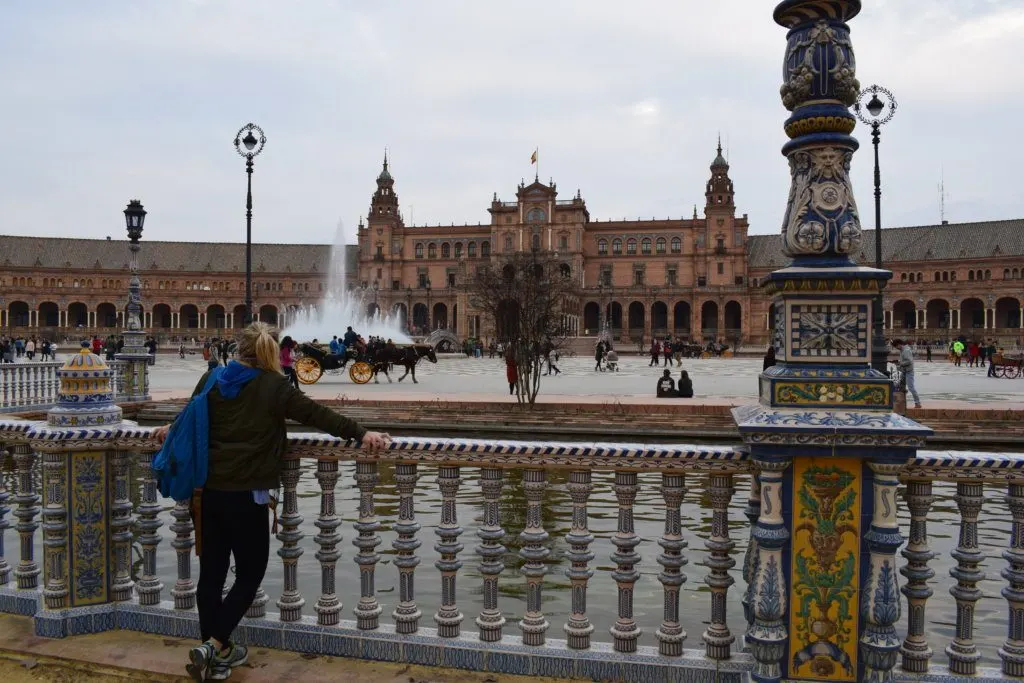
Exploring Plaza de Espana in Seville, Spain
San Sebastian
“If you’re a surfer then you need to put San Sebastian on your winter bucket list.
This stunning spot in northern Spain has great weather, fantastic beaches, an atmospheric old town with authentic Basque pintxos bars and some of the best coastal scenery in Spain.
In fact, winter is one of the best seasons to choose to go surfing, as San Sebastian’s winter months are mild and the winter waves are big and consistent.
The best time is in December as the water temperature on a sunny winter’s day can get as warm as 60F/16C.
Visiting in December is also a great time to soak up the Christmas atmosphere of the Old Town while tasting the delicious local cuisine on a pintxos bar crawl.
Other things to do in San Sebastian include strolling along La Concha Promenade, admiring public art and exploring cathedrals, squares and museums.”
– by Christina, author of Travel2Next

View over San Sebastian, photo by Travel2next
Malaga
“Malaga is a wonderful December destination, with daytime temperatures in the high teens (Celsius). Evenings are cooler, but a sweater or light jacket will keep you cozy.
You can expect sunshine more often than not, and even if it does rain, it does not generally last that long.
There are lots of things to do in Malaga, including exploring the historical center, sampling the delicious food, and walking the beautiful waterfront.
Eat roasted chestnuts, enjoy a relaxing soak in a Hammam, and admire the magnificent Christmas lights display, considered one of the best in Europe.
There is a light and sound show on Calle Larios you can enjoy in the evening. Stroll the Christmas markets, or take in a free concert.
You can enjoy boating or hiking in one of several parks in the area if you love the outdoors. And if you enjoy history and art, pick from some of the many exhibitions in the city museums!”
– by Dhara, author of It’s Not About the Miles

The Alcazaba of Malaga, photo by Not About The Miles
Palma de Mallorca
“Despite its reputation for package holidays, the quaint city of Palma, capital of the island of Mallorca has emerged as a go to destination for foodies and sun seekers throughout summer and into the cooler months.
The entire island can get rammed through the summer months however, with both Spaniards and other European tourists heading to soak up the Med sun.
As a result, the time to explore this wonderful city is probably during the Autumn and Winter months.
Heading there during October-December time is perfect, when you can expect quiet streets, cheaper prices and still get the chance to explore some of the wonderful food markets, restaurants and bars on offer, all whilst keeping up weather around 20C and plenty of sunny days!”
– by Laura, author of The Travelling Stomach

Drinks with a view in Palma de Mallorca, photo by The Travelling Stomach
Cordoba
“Córdoba is a stunning city in the south of Spain that has an important historical legacy and it should be a mandatory destination in Spain.
With warm temperatures all year round, it is a good winter destination in Europe, as it can be too hot in Summer.
Córdoba used to be one of Europe’s most important cities – the capital of Islamic Spain and a prominent center for education and learning in Europe.
It is was home to the Morish for nearly 500 years, and even today has a big Moorish influence in the city, especially in the architecture.
The most important site in Cordoba is the Mosque-Cathedral of Córdoba. A Catholic church transformed into a Mosque and converted back to a church.
An impressive building with different influences and styles, particularly known for its red and white arcs.
Besides the Great Mosque-Cathedral, which is itself a good reason to visit Córdoba, you have the Roman Bridge, the Alcazar, the Jewish quarter. Moreover, the city has a good night vibe and delicious food.”
– by Claudia Bastos, author of Travel Drafts

The inside of the Great-Mosque Cathedral of Cordoba, photo by Travel Drafts
Formentera
“The Balearic Island of Formentera is a stunning destination to visit at any time of the year. But, it’s also immensely popular in the summer months which results in crowded beaches and inflated prices.
Winter, however, sees quiet coastlines, local life flourishing, and more affordable (albeit more limited) accommodation options. The key to enjoying Formentera in the winter months is to expect stillness & solitude.
It’s the perfect escape to enjoy clear blue sunny days, and even though it’s still a little chilly, the mild climate means the days aren’t unbearably so.
Pack your walking shoes to make the most of the island’s trails and partake in a local yoga lesson to shake off the winter blues. And if the quiet life gets too much, the bustling city of Ibiza is just a short ferry ride away!”
– by Nadine, author of Le Long Weekend
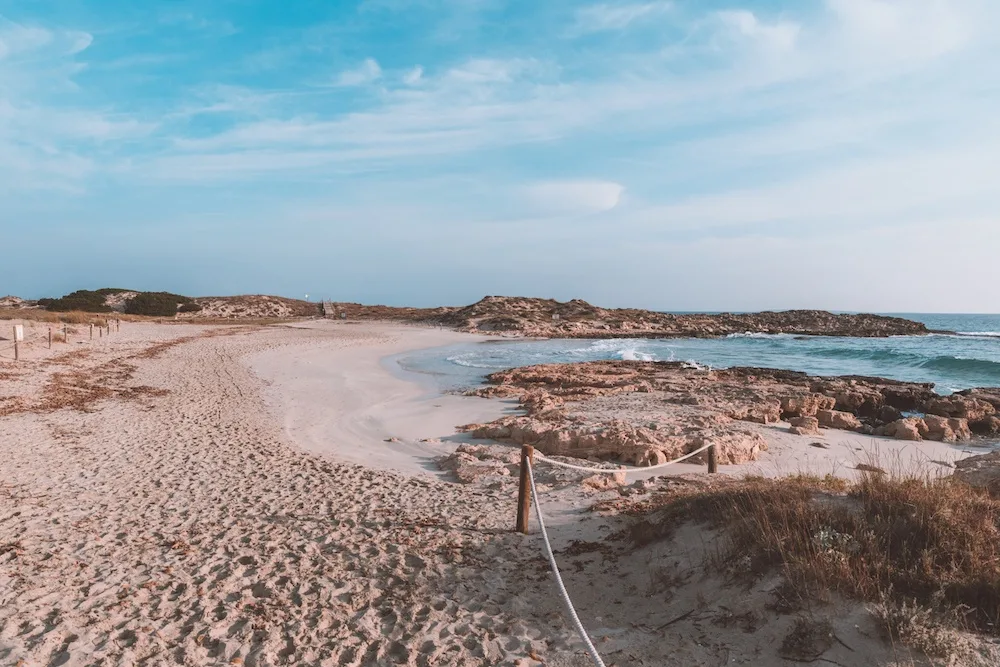
One of the beaches in Formentera, photo by Le Long Weekend
Granada
“When seeking winter sun in Europe, Granada makes an excellent choice. The weather in Andalusia during this time of year is mild with plenty of sunny days.
While you won’t get the typical Andalusian summer heat, you can expect to see highs of 16°C during the day with cool temperatures in the evenings and mornings.

The Alhambra of Granada, photo by The Road Is Life
The best thing about travelling to Granada during the winter is that you can visit Spain’s most popular palace when it isn’t overcrowded.
The beautiful Alhambra attracts over 2 million tourists per year and most of them choose to visit during high season.
Perched on the top of a hill, overlooking the city of Granada with a backdrop of snowy mountains – it’s easy to see why this impressive palace brings in the masses!
When I visited in February, I was thrilled to have excellent weather with minimal crowds. Ditch the long queues and hordes and visit the Alhambra in February for a much more enjoyable experience!”
– by Ann, author of The Road Is Life

The Alhambra of Granada, photo by The Road Is Life
The best winter sun in the Canary Islands
Corralejo, Fuerteventura
I know the Canary Islands are technically part of Spain, but they’re so far and different from the rest of Spain that I wanted to write about them in more detail in a separate section.
I’ve had the opportunity to visit a number of different islands and even towns within the same island over the years, and have included in this round up my favourites.
The town of Corralejo in Fuerteventura is amongst my favourite places in the world.

Sunset in Corralejo, Fuerteventura
Corralejo is a fairly small town in the north of the island, famous for the Corralejo National Park around it and the prime surfing beaches.
It’s one of the best surfing spot in the Canary Islands, especially for beginners, and it’s especially good in winter when the waves are longer and easier to surf.
The temperatures range from 16°C to 22°C even in the coldest months of December and January.

Surfing in Fuerteventura in the Canary Islands, Spain

Learning to surf in Fuerteventura with Planet Surf Camps
The town itself is quite small, but offers a lot of choice when it comes to bars, restaurants and shops.
You can spend your days surfing, cycling or quad biking around the sand dunes of Corralejo National Park, snorkelling at the nearby island of Lobos or just sitting on a beach and enjoying the winter sun.
It’s one of the places I often consider moving to when on cold and rainy days I want to run away from London.

Cycling around the sand dunes of Corralejo Natural Park, Fuerteventura
Lanzarote
“During the winter months day time temperatures hover around 20 degrees in Lanzarote and the sea can (just about) be warm enough to swim in.
But you may be thinking that the stereotypical package holiday resorts and Irish bars of Lanzarote aren’t quite for you? Well step away from the main resorts and you will find a wild and barren island, waiting to be explored.
Indeed it is very possible to get off the beaten track in Lanzarote, and winter is a the perfect time for hiking and cycling around the island.
Base yourself in the north of the island which offers the most panoramic views and unspoilt towns, as well as some beautiful secluded beaches. I advise hiring a car to get around as public transport is limited.”
– by Jenny, author of TraveLynn Family

Orzola Beach in Lanzarote, photo by TraveLynn Family
Gran Canaria
“The weather in Gran Canaria is warm and sunny all year round, especially along the southern coast.
While most people head to the beachy resort of Maspalomas – which has the best weather of all and pretty much guaranteed sunshine – the rest of the island has a lot to offer too.
The capital has plenty of history to soak in, as well as plenty of unique foodie treats – many of them undercover, in case a rare day of rainfall does hit.
As well as its beaches and cities, Gran Canaria has plenty of mountainous areas to hike and explore in the centre, making it great for a winter trip that involves a little bit of everything.”
– by Jodie, author of Alajode
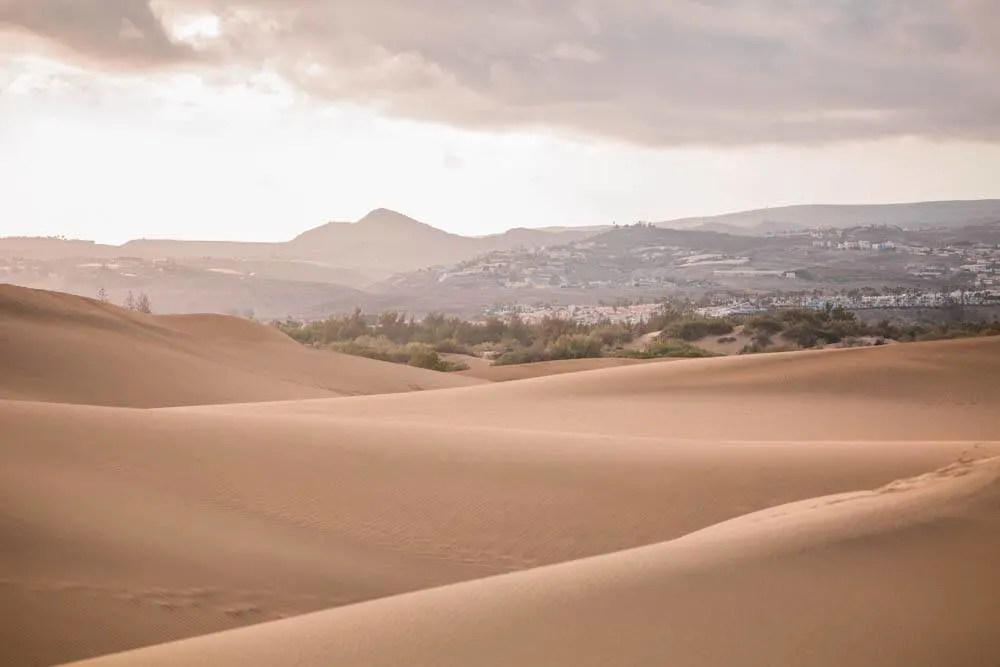
The sand dunes of Gran Canaria, photo by Alajode

Cute town streets in Gran Canaria, photo by Alajode
Warmest places in France in winter
Nice
“Situated on the Cote D’Azur in the South of France, Nice is a fabulous city to soak up a bit of winter sun.
The climate is typically Mediterranean with temperatures averaging around 16 degrees October – March, and only 5-6 days of rain per month.
The best winter month to visit Nice has to be February, when the city holds a huge carnival for around 2 weeks each year.
Expect dancing in the street, music, and a procession of incredible floats making their way through the city every day and night throughout the festival.
It’s great fun for the whole family. February also happens to be the month of winter sales in France, so it’s the perfect time to pick up a bargain!”
– by Heather Frew, author of My Kitchen Travels

Sunset in Nice, photo by My Kitchen Travels
Marseille
“If you are looking for a winter break in France with some sun, Marseille is the place to go. Marseille is located in one of the French Regions of Southern France, in Provence Alpes-Côte d’Azur.
Winters in Marseille are never too cold (11 to 16C) and when the sun shines it is possible to leave the jacket at the hotel for some hours.
Wander around the old port with its fish market and visit the historic neighbourhood of Le Panier for some local life or climb up to Basilique Notre Dame de la Garde to see one of the most cherished places by the locals and some great views over the Mediterranean Sea.
Use the coldest hours of the day to visit the MuCEM, a relatively new museum focused on Mediterranean culture and civilization or to get a taste of the Provencal cuisine and its excellent wines.”
– by Elisa, author of France Bucket List
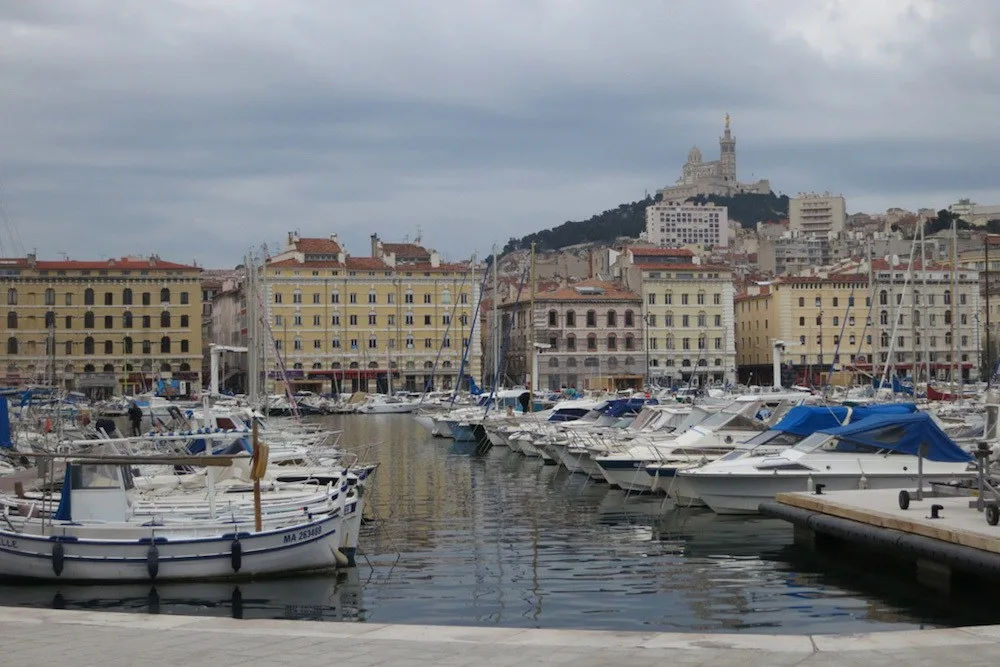
The harbour of Marseille, photo by France Bucket List
Best places to visit in Greece in winter
Rhodes
“The Greek island of Rhodes is a popular summer getaway, but thanks to its southerly position in the Aegean Sea it makes a great city break well into the winter months.
Rhodes has a mild climate with an average temperature of 13° over the winter – downpours are frequent but brief so you should have plenty of sunny spells to enjoy walking the streets of the impressive medieval old town.
November is a great time to visit – the island is quiet but beach days are still a possibility and the sea is warm enough for swimming.

Street of the knights in Rhodes, photo by The Mediterranean Traveller
Unlike most Greek islands Rhodes doesn’t completely close down for the winter. Rhodes Town is a university town and working port city so it has a bit of a buzz (and plenty of bars and restaurants open) year-round.
There’s an increasing number of great places to stay on Rhodes – with plenty of cosy boutique hotels within the old city walls, and posh spa hotels if you’re willing to stay a bit further out.”
– by Steph, author of The Mediterranean Traveller

The Grand Masters Palace in Rhodes, photo by The Mediterranean Traveller
Santorini
“Santorini in winter is the absolute best time to visit this much-loved Greek Island. The weather here is relatively warmer than the rest of Europe and is the perfect temperature to explore.
November is probably the best option with regards to the weather, but even in December, we had little rain and the temperature reached 18 degrees Celsius.
The incredible benefit of visiting Santorini at this time of year, is the lack of crowds. You can enjoy Santorini at your own pace, avoiding the cramped tourist conditions of the summer months.
Add to that, the cheaper hotels, cheaper car rental and being able to photograph Santorini’s sensational sights without hundreds of tourists in your shot, makes it the perfect warm winter getaway.
Top 5 Things to do:
- Hike to Skaros Rock
- Wander the iconic streets of Oia
- Walk along the dark volcanic sands of Perissa Beach
- Hike the Caldera
- Visit Akrotiri Lighthouse”
– by Shelley, author of Lifejourney4Two

The iconic white houses of Santorini, photo by Life Journey 4 Two
Mykonos
“The Greek Islands are a great place to head to for a sunny winter escapade, and Mykonos is a wonderful choice – after all, in high season it’s so crowded that it’s almost impossible to enjoy it, while in winter you can easily find affordable flights and places to stay.
February and March are the best winter months to visit Mykonos, as the temperature sometimes rises up to +20° or higher, making it possible to sit comfortably on the beach, and even jump in for a quick dip if you’re feeling brave!
Mykonos town has several accommodation options, which are open even in winter. The best beaches of Mykonos to enjoy in winter are the ones on the southern coast, usually sheltered from the wind.”
– by Margherita, author of The Crowded Planet

One of the beautiful beaches in Mykonos, photo by The Crowded Planet
Warmest places in Portugal in winter
Lisbon
“When winter sets in and you need a little bit of sunlight, it’s hard to go past Portugal’s buzzing capital Lisbon. In many respects, Lisbon is actually an easier city to enjoy outside of the peak summer season.
Exploring the city on foot and its undulating hills is a whole more manageable when the mercury isn’t rising. If the sun hasn’t done its job, Lisbon’s well known foodie scene certainly will.
From the gourmet selection of the Time Out Lisbon market, the grungy restaurants of the Alfama or the sweet treats at Pasteis de Belem, there is something for everyone’s palette.
Travelling in lower demand periods means less lines for one of the most popular things to do in Lisbon, a ride on the #28 tram.
This iconic tram winds its way through the streets of Lisbon, banging and shaking as the driver weaves through the narrowest of streets. The views from St Georges Castle of Lisbon will also be that little more tranquil.
Whilst you’ll still need a jacket or a jumper, Lisbon is a beautiful city to explore in winter.”
– by Jeff, author of Our Passion For Travel

The colourful houses of Lisbon, photo by Our Passion For Travel
Algarve
“The Algarve coast in the south of Portugal is one of the warmest places in Europe during winter. You can expect mostly sunny days and temperatures from 16°C – 19°C on average. However, it’s nicest in February and March.
While the rest of Europe is still struggling with cold and snow, it’s already spring in the Algarve region! It can become almost summerly warm during day time and you definitely should not forget to pack some sunscreen!
The Algarve coast is famous for their stunning lime stone formations and stunning beaches. One of the nicest is the Praia de Marinha.
While this beach is very crowded during summer, it’s possible that you’re the only visitor during winter.”
– by Lena, author of Salut From Paris

Sunny beaches in the Algarve coast, photo by Salut From Paris
Azores Islands
The Azores are one of those destinations that I had never really considered much, but after visiting them this summer I absolutely fell in love and will never stop recommending them to everyone I know.
I spent 10 days in the Azores in August, however the weather is surprisingly not massively different from winter. In summer temperatures in the Azores range from 20°C to 25°C, whilst in winter they go from 13°C to 18°C.

The natural rock pools of Biscoitos on Terceira Island in the Azores
Located in the middle of the Atlantic Ocean, the Azores are the perfect destination for someone looking for an outdoors adventure, when everywhere else in Europe it’s too cold to spend long periods of time outside.
There are stunning hikes and landscapes on all the islands, that you can pleasantly enjoy during any of the winter months.
We visited Terceira, Sao Jorge, Pico and Faial, and found beautiful rock pools and stunning views in each of the islands.

One of the stunning viewpoints on Terceira Island, Azores
My personal favourite island was Sao Jorge, as I felt it had the most stunning landscapes and most adorable towns.
However Terceira has a bigger town centre so if you’re visiting in low season in winter you might want to be on a more lively island.
Regardless of which island you choose, you’re guaranteed to find mild weather, stunning views and challenging hikes on each island.
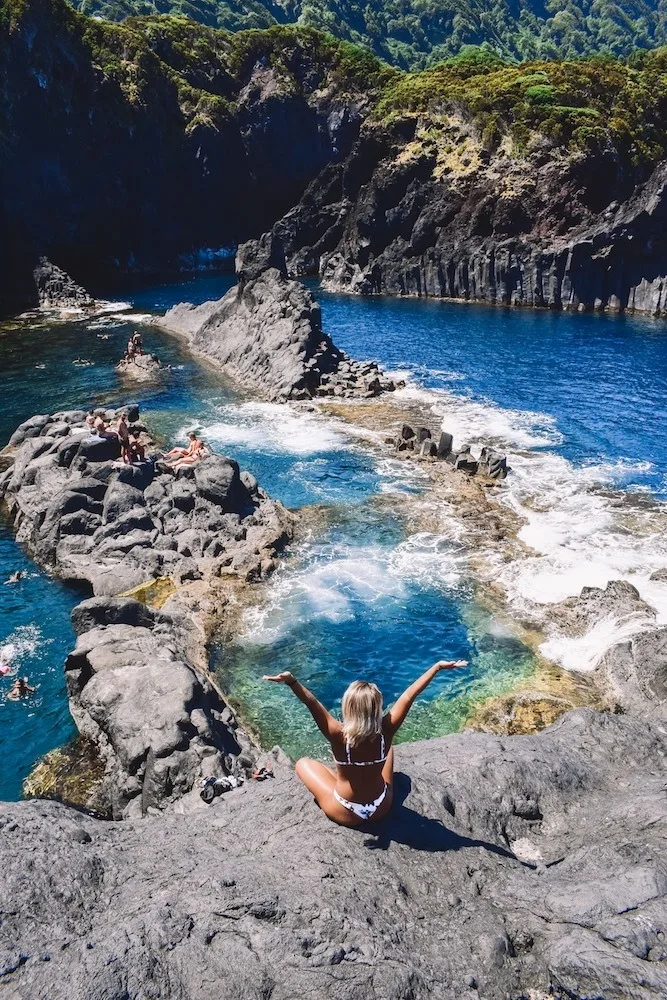
The natural rock pools of Simao Dias in Sao Jorge Island, in the Azores
Other awesome European winter sun destinations
Paphos, Cyprus
“Paphos in Cyprus is a great choice if you want to get away from grey winter weather in the rest of Europe.
Temperatures reach around 20 degrees in December and just a few degrees lower in January and February, making it an ideal place to spend a few days.
February is probably the best month to visit overall, as there’s less rain, and more chance of (increasingly) freak early year warm days.
There are many things to do in and around Paphos to keep you occupied for several days. The Tomb of the Kings and the Kato Paphos Archaeological Park are among the places you should definitely visit.
You will be impressed by the amazing mosaics, and also by the sheer size of the site itself. Although you will probably not find it warm enough to swim, you could also head out to see some of the beaches.
Aphrodite’s rock, in particular, is very famous and it will be pleasantly quiet in winter. There’s also a few shipwrecks you can check out nearby.”
– by Dave, author of Dave’s Travel Pages

One of the shipwrecks in Paphos, Cyprus, photo by Dave’s Travel Pages
Malta
“Malta, an island in the middle of the Mediterranean, is a fantastic winter sun break. With 300 days of sunshine every year, Maltese winters are mild to say the least.
As a Christian country, visiting Malta in December will coincide with many Christmas themed activities taking place.
The atmosphere in the capital Valletta is festive with a dazzling display of Christmas decorations and lights throughout the city streets. Best to avoid November which is the wettest month on the sunny island.
With 7000 years of history, the entire island is one giant outdoor museum with global influences in food and culture. There’s an astonishing array of things to discover in Malta.
History loves should visit Valletta, Rabat and Mdina for museums and cultural attractions. For the adventure travellet there’s a plethora of hiking options available.
The Islands’ scenery and architecture provide a spectacular backdrop. Expect eggshell-coloured stone against striking and rich blues of the Mediterranean waters glistening all around you.”
– by Roma, author of Roaming Required

The beach in Malta, photo by Roaming Required
Taormina, Italy
“Taormina is a gorgeous cliffside town in Sicily. Due to the high mountainous slopes there is a sort of micro-climate that makes Taormina a pleasurable year-round destination.
Taormina is also a great place to base yourself in Sicily as it’s close to both the north and east coasts.
Even if you aren’t going on to explore Mount Etna and surrounds, Taormina is a beautiful place to stay in Italy in winter as there is lots to do.
Venture out to the Ancient Greek Theater and The Duomo, peruse cutesy cafes like Wunderbar Caffe or stroll the lovely pedestrian streets like Corso Umberto.
Winter is quite mild with temperatures shifting between around 7-14C at its lowest. Skip rainy December and visit during October, which is great as the weather is good and the temperatures moderate (15-23C).
So you may still be able to even get in some beach time around Isola Bella (not the island in Lago Maggiore).
Don’t forget to have a sunset aperitivo at the Belmond Grand Timeo with sweeping views of the mountains to the side and ocean below.”
– by Cal, author of Once In A Lifetime Journey

Belmond Grand Hotel Timeo in Taormina, photo by Once In A Lifetime Journey
Final thoughts on the warmest places in Europe in winter
Do you have a place somewhere in Europe you like to run off to for some winter sun? Let me know in the comments below!
This is just a compilation of mine and other travel bloggers favourite warm destinations in Europe in winter, if you have a favourite that isn’t on this list let me know about it, I’d love to include it!
I hope you find this post useful in planning your European winter sun escape.
Enjoyed reading about the best winter sun destinations in Europe? Pin it!




